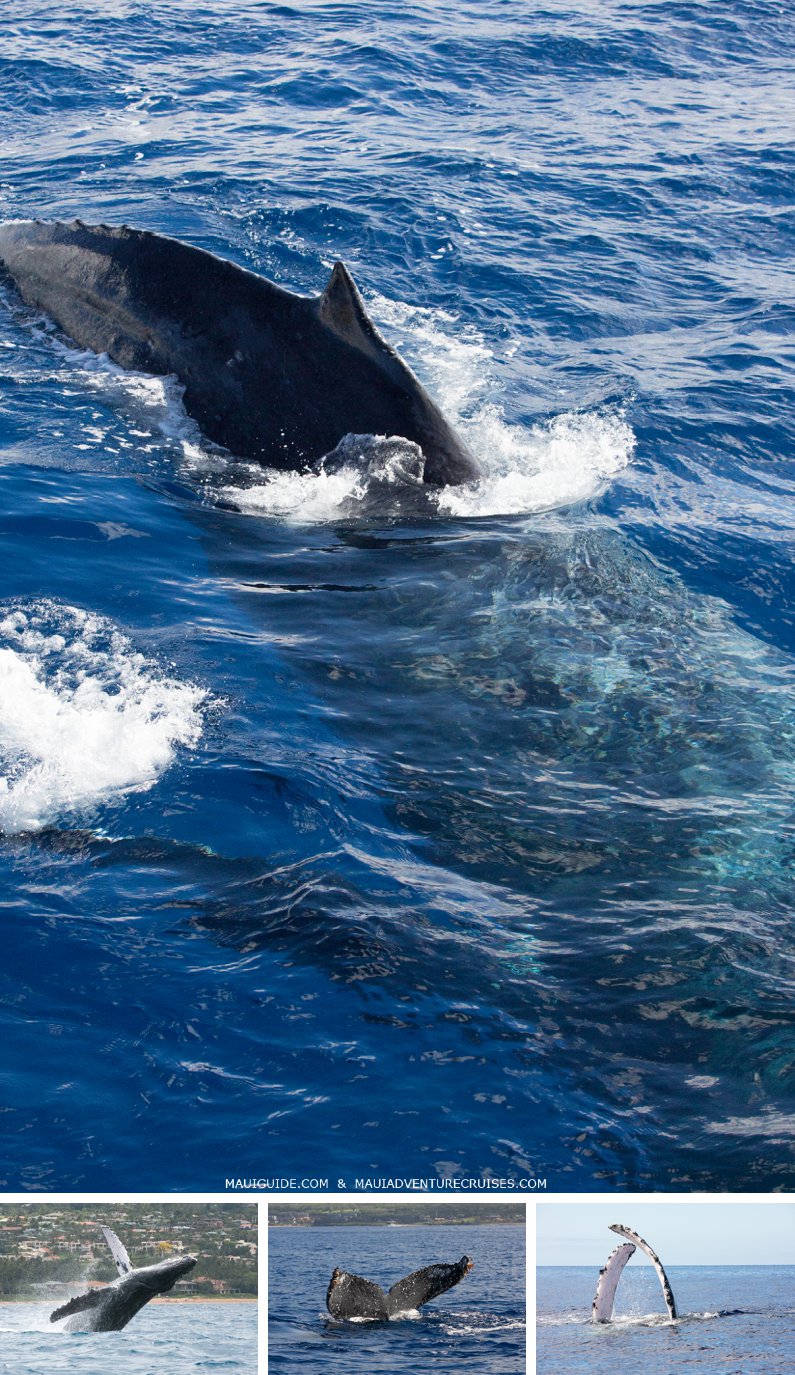Humpback Whale Watching
Maui Whale Watching Tips
Maui, Hawaii is known for its abundance of humpback whales and offers some of the best whale watching experiences in the world. Here are some tips to make sure your trip goes smoothly:
- Plan your trip during peak months – Late December through April is prime whale-watching season in Maui.
- Choose a spot with a clear view – Look for spots that offer an unobstructed view of the open ocean where you can spot far-off whales more easily. Obviously, being out on a boat is the best way to see them well.
- Research local rules and regulations – Make sure you’re familiar with any laws or regulations about approaching whale pods or capturing pictures or video (drones) of humpback whales. If you go on a permitted whale watch, you won’t have to worry about this. Your captain and crew know what to do.
- Check out educational opportunities beforehand – Take advantage of any guided tours or educational programs offered by local organizations. They can teach you more about the humpback whale and help you have a safe and enjoyable experience. Head to Maui Ocean Center, do a Maui whale watch tour, and visit the Hawaiian Islands Humpback Whale National Marine Sanctuary in Kihei. Learn about how humpback whales migrate, feel actual baleen plates, get acquainted with the endangered species act, learn how humpback whales feed in Alaska, and more about our beloved humpback whale.


15 Humpback Whale Facts You Don’t Know!
- Even if you’ve been on a dozen whale watches, there’s a good chance you didn’t know the following facts about humpbacks.
- Humpback whales experience rapid growth during their initial year of life, reaching lengths of up to 30 feet.
- Their mating process includes internal fertilization; however, physical evidence of intromission has never been recorded in Hawaiian waters. Despite the lack of direct observation, researchers can still establish paternity through the examination of a whale’s genetic makeup. This allows us to better understand the fascinating life cycle and biology of these magnificent creatures.
- In Hawaii, a significant 80% of humpback whale mother and calf groups are frequently accompanied by a third adult whale, known as an escort. Interestingly, this escort is not the calf’s biological father. The escort’s association with the mother and calf is typically short-lasting, often only for a few hours. This transient relationship can possibly be attributed to the fact that lactating female whales are less likely to ovulate, making them unappealing as potential mating partners.
- Humpback whale populations across the globe exhibit remarkable distinctions in their vocalizations, known as songs. Despite the differences in songs between various global populations, it is notable that all the male humpback whales within a single population share the same song. This highlights the uniqueness of each community’s communication methods.
- Humpback whales were not targeted by whaling fleets operating in Hawaiian waters. This historical absence of active hunting could be a contributing factor in the region’s importance as the primary breeding ground for North Pacific humpback whales today. The relative safety provided in the Hawaiian waters may have allowed these magnificent creatures to thrive and maintain their unique breeding patterns.
- One of the primary disturbances impacting humpback whales is the issue of acoustic harassment. The increasing utilization of low-frequency sonar in military activities has raised alarm among environmental organizations.
- The exact purpose of the humpback whale’s unique song remains uncertain. It is hypothesized that the song may communicate physical fitness or an inclination to mate, establish dominance over a particular territory, or even function as a challenge directed toward rival males.
- Among the various demonstrative behaviors exhibited by humpback whales, the peduncle slap or throw stands out as the most aggressive one observed by researchers. In this striking exhibition, the whale propels the entire posterior half of its body above the water’s surface and forcefully slams it down sideways, generating a powerful display. This conduct appears to be primarily targeted at either another whale or a nearby boat.
- Humpback whales, which can be discovered in every ocean on Earth, embark on an annual migration from their summer habitats in the cold polar waters to their warm, tropical breeding locations each winter. During their time in the mating areas, these magnificent creatures are typically found dwelling in shallow waters, often no deeper than 600 feet (making the region between the islands in Maui County prime whale-watching areas.) This pattern of migration allows them to access an ample supply of food during the summer months while providing a suitable environment for breeding and raising their young in the winter. The journey of these magnificent marine mammals showcases the splendid diversity and adaptability of the humpback whale species, as well as their reliant connection to both polar and tropical marine ecosystems.
- Humpback whales exhibit the unique characteristic of being voluntary breathers, which indicates the absence of an innate breathing reflex in their system. Consequently, they are vulnerable to suffocation and death in situations where they lose consciousness.
- Although humpback whales lack functional vocal cords commonly used for producing sound, their highly developed larynx compensates for this drawback. Within the larynx, there is a significantly large chamber known as the diverticulum. These magnificent creatures manage to produce sound by expelling air through the diverticulum and the larynx folds, subsequently channeling it into their sturdy nasal passages. This process creates pressure variances that ultimately generate sound.
- Upon departing their feeding grounds, humpback whales might carry an enormous load of barnacles attached to their head and flippers, sometimes weighing up to a ton. The majority of these barnacles detach from the whales once they reach warmer waters.
- A large number of humpback whales can be identified by the distinct circular scars left on their bodies. These marks are the result of puncture wounds inflicted by a small species of shark known as the “cookie-cutter” shark, leaving a visual testament to the encounters between these two marine creatures.
- The auditory perception of a humpback whale plays a crucial role in its ability to communicate, as sound waves have a more extended range in aquatic environments compared to light. This means that their hearing is even more valuable than their eyesight for interaction with fellow whales.

With Maui Adventure Cruises, you can experience the wonder of whale watching in an unforgettable and safe way just off the Lahaina coastline. Traveling with experts on board, Maui Adventure Cruises is ready to take you out on their ocean expeditions to discover humpback whales in their natural habitat.





